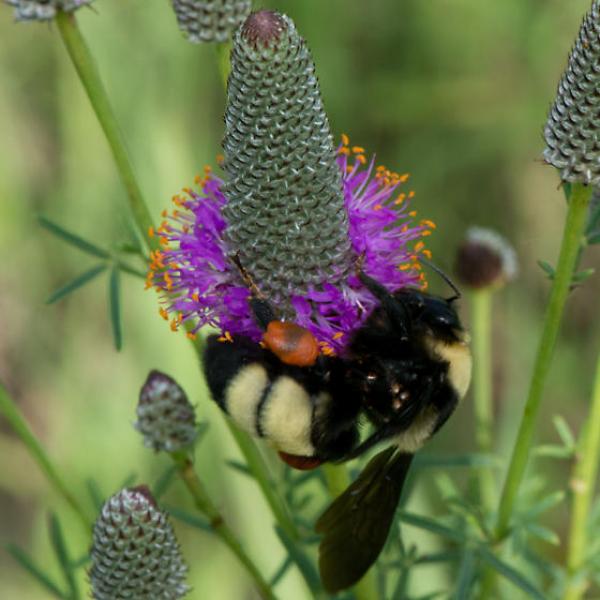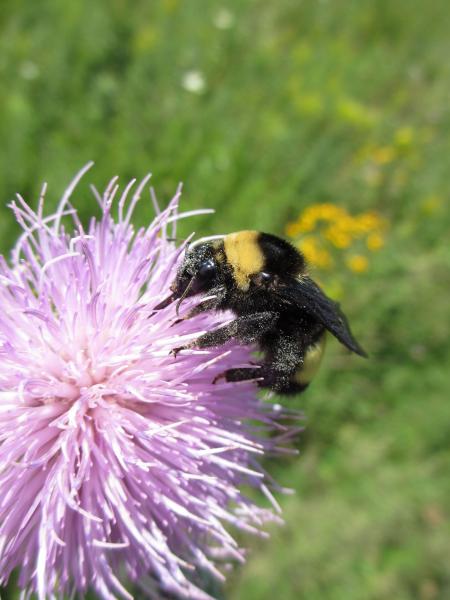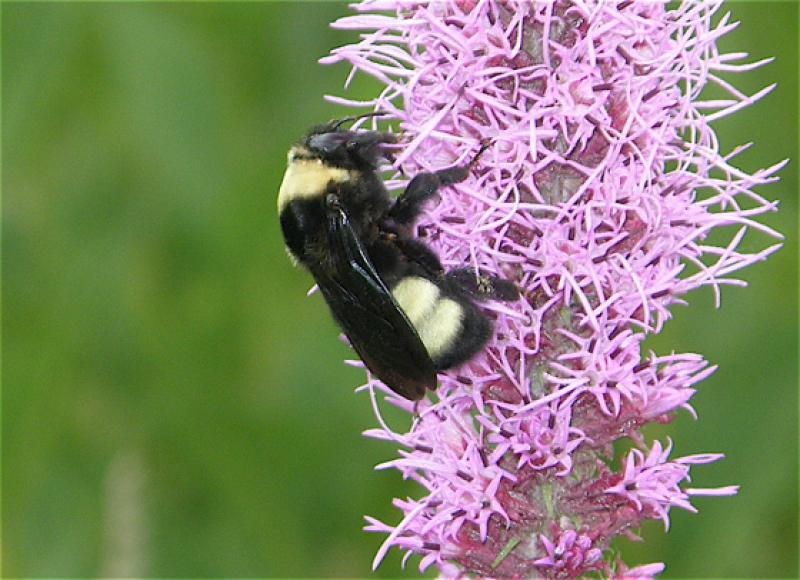Black and Gold Bumble Bee
Bombus auricomus (Robertson, 1903)
- Class
- Insecta (Insects)
- Family
- Apidae (Triepeolus)
- State Protection
- Not Listed
Not listed or protected by New York State.
- Federal Protection
- Not Listed
- State Conservation Status Rank
- S2
Imperiled in New York - Very vulnerable to disappearing from New York due to rarity or other factors; typically 6 to 20 populations or locations in New York, very few individuals, very restricted range, few remaining acres (or miles of stream), and/or steep declines.
- Global Conservation Status Rank
- G5
Secure globally - Common in the world; widespread and abundant (but may be rare in some parts of its range).
Summary
Did you know?
Black-and-gold Bumble Bees (Bombus auricomus) are very similar in appearance to Nevada Bumble Bees (Bombus nevadensis). However, Nevada Bumble Bees are a western species and have not been documented in New York.
State Ranking Justification
The Black-and-gold Bumble bee has been documented in 18 counties in New York State. There are an additional seven counties with historical records (1999 and earlier) (White et al. 2022). Threats to Bombus auricomus include habitat loss, pesticides, and urbanization (Schweitzer et al. 2012) as well as pollution and invasive species. This sub-genus (Bombias) does not appear to be experiencing high susceptibility to the protozoan N. bombi, a pathogen attributed to playing a large role in the decline of Bombus and Thoracobombus sub-genera.
Short-term Trends
The short-term trends for this species are unknown.
Long-term Trends
Based on data from the Empire State Native Pollinator Survey, the current (2000 to present) and historical (1999 and earlier) distribution in NY has remained relatively stable. While there appear to be seven counties no longer occupied that were historically, there are also several new county records in recent years (White et al. 2022).
Conservation and Management
Threats
Threats to Bombus auricomus include habitat loss, pesticides, and urbanization (Schweitzer et al. 2012) as well as pollution and invasive species. This sub-genus (Bombias) does not appear to be experiencing high susceptibility to the protozoan N. bombi, a pathogen attributed to playing a large role in the decline of Bombus and Thoracobombus sub-genera.
Conservation Strategies and Management Practices
Any efforts to protect wild bumble bee populations from pathogen exposure would benefit Black-and-gold Bumble Bees. Suggested actions would include using mesh to prevent escape of bees from commercial breeding greenhouses, proper disposal of commercial bees, sanitation in greenhouses, and development of molecular screening. Tight restrictions on importing bumble bees and elimination of parasites from commercial populations has been suggested as ideal (Meeus et al. 2011, Schweitzer et al. 2012).
Minimal to no exposure of Black-and-gold Bumble Bee to insecticides would also benefit them. Suggested actions include avoidance of application to flowers that bumble bees are attracted to and application of solutions or soluble powders (rather than dusts or wettable powders) to the ground in calm wind and warmer temperatures during periods of dewless nights to minimize the impact to resident bumble bee populations (Schweitzer et al. 2012). Organic farming has also been suggested to benefit bumble bees.
Research Needs
Further research is needed to determine more information on habitat requirements, threats, climate change effects, and insecticide effects for Black-and-gold Bumble Bees.
Habitat
Habitat
Bumble bees are generalist foragers and need nesting habitat in the spring, flowers for adult and larval nutrition throughout the spring and summer, and sites for queens to overwinter. This bumble bee nests underground (Colla et al. 2011). Such species often use abandoned rodent nests underground in south facing exposures. Foraging habitat should include flower abundance and species richness with overlapping blooms to ensure nectar availability throughout the growing season (Schweitzer et al. 2012). Select food plants for B. auricomus include clovers, bee balms, Solanum, Hypericum, and Eupatorium (Colla et al. 2011). Suitable sites for bumble bees to overwinter may include rotting logs, mulch, or loose soil (Schweitzer et al. 2012).
Range
New York State Distribution
The Black-and-gold Bumble bee has been documented in 18 counties in New York State. There are an additional seven counties with historical records (1999 and earlier) (White et al. 2022).
Global Distribution
The Black-and-gold Bumble Bee range includes the eastern United States south to Florida and west to Wyoming, and in Canada, the range includes Ontario and possibly Saskatchewan west to British Columbia (NatureServe 2023).
Identification Comments
Identifying Characteristics
Black-and-gold Bumble Bee queens, workers, and males have a long-shaped face and at least some yellow hairs on the top of their head and yellow banding on the thorax. Abdominal segment one usually has at least some yellow, especially laterally. Segments two and three are yellow, with the last segments black (Colla et al. 2011).
Best Time to See
Bumble bee queens hibernate over the winter, emerge in the spring, locate a nest site, and rear young (workers, males, and new queens). After new queens and males mate, all males, workers, and old queens die by the beginning of winter and new queens settle into sites to overwinter (Schweitzer et al. 2012).
- Active
- Reproducing
The time of year you would expect to find Black and Gold Bumble Bee active and reproducing in New York.
Similar Species
- American Bumble Bee (Bombus pensylvanicus)
(guide)
American Bumble Bees have all black hairs on the top of the head, while Black-and-gold Bumble Bees have at least some yellow hairs on the top of the head (Colla et al. 2011).
Black and Gold Bumble Bee Images
Taxonomy
Black and Gold Bumble Bee
Bombus auricomus (Robertson, 1903)
- Kingdom Animalia
- Phylum Arthropoda
(Mandibulates)
- Class Insecta
(Insects)
- Order Hymenoptera
(Bees, Wasps, Ants, Sawflies)
- Family Apidae (Triepeolus)
- Order Hymenoptera
(Bees, Wasps, Ants, Sawflies)
- Class Insecta
(Insects)
- Phylum Arthropoda
(Mandibulates)
Comments on the Classification
The scientific name for this species has not changed. However, NatureServe did not have a record of it occurring in NY. There are at least 4 occurrences since 1980 for this species that we will begin tracking. One of the records is considered "current" and post 2000 based on Richardson 2013 compiled dataset.
Additional Resources
References
Bachman, S., J. Moat, A. Hill, J. de la Torre, and B. Scott. 2011. Supporting red list threat assessments with GeoCAT: geospatial conservation assessment tool. In: Smith, V. and L. Penev (Eds) e-Infrastructures for data publishing in biodiversity science. ZooKeys 150: 117-126. (Version BETA). Available online at: https://www.kew.org/science/our-science/projects/geocat-geospatial-conservation-assessment-tool.
Cameron, S.A., J.D. Lozier, J.P. Strange, J.B. Koch, N. Cordes, L.F. Solter, and T.L. Griswold. 2011. Patterns of widespread decline in North American bumble bees. PNAS. 108 (2): 662-667.
Colla, S., L. Richardson, and P. Williams. 2011. Bumble bees of the eastern United States.
Meeus, I., Brown, M.J.F., DeGraaf, D.C., and G. Smagghe. 2011. Effects of invasive parasites on bumble bee declines. Conservation Biology 25(4): 662-671.
NatureServe. 2023. NatureServe Network Biodiversity Location Data accessed through NatureServe Explorer [web application]. NatureServe, Arlington, Virginia. Available https://explorer.natureserve.org/.
New York Natural Heritage Program. 2024. New York Natural Heritage Program Databases. Albany, NY.
Poole, R. W., and P. Gentili (eds.). 1996. Nomina Insecta Nearctica: a checklist of the insects of North America. Volume 2 (Hymenoptera, Mecoptera, Megaloptera, Neuroptera, Raphidioptera, Trichoptera). Entomological Information Services, Rockville, MD.
Richardson, L. 2013. Compilation of specimen records for Bombus species of North America from the American Museum of Natural History, Harvard Museum of Comparative Zoology, among several other museums. Unpublished data.
Schweitzer, D. and N. Sears. May 1, 2013. Bumble bee ranking guidelines. NatureServe, Arlington, VA.
Schweitzer, D.F., N.A. Capuano, B.E. Young and S.R. Colla. 2012. Conservation and management of North American bumble bees. NatureServe, Arlington, Virginia, and USDA Forest Service, Washington, D.C. 17 pp.
White, Erin L., Matthew D. Schlesinger, and Timothy G. Howard. 2022. The Empire State Native Pollinator Survey (2017-2021). New York Natural Heritage Program. Albany, NY.
Williams, P.H., R.W. Thorp, L.L. Richardson, and S.R. Colla. 2014b. Bumble bees of North America: an Identification Guide. Princeton University Press. 208 pp.
Yanega, D. 2013. Compilation of specimen records for Bombus species of North America from the University of California Riverside Entomology Research Museum, the Essig Museum of Entomology, University of California Berkeley, the Natural History Museum of Los Angeles County and the California State Collection of Arthropods. Unpublished data.
Links
About This Guide
This guide was authored by: Erin L. White
Information for this guide was last updated on: September 19, 2023
Please cite this page as:
New York Natural Heritage Program. 2024.
Online Conservation Guide for
Bombus auricomus.
Available from: https://guides.nynhp.org/black-and-gold-bumble-bee/.
Accessed July 27, 2024.


